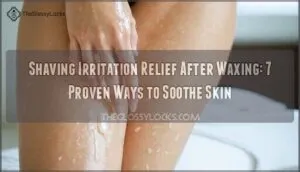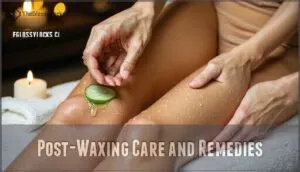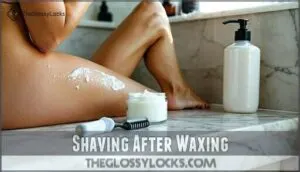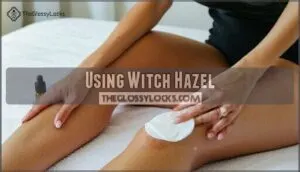This site is supported by our readers. We may earn a commission, at no cost to you, if you purchase through links.

For shaving irritation relief after waxing, start with a cold compress to reduce inflammation and redness. Apply aloe vera gel or witch hazel to soothe the area.
Avoid tight clothing, hot showers, and fragranced products for 24-48 hours. Take an oatmeal bath to calm irritated skin.
Use a gentle, fragrance-free moisturizer to restore your skin’s barrier. If bumps appear, tea tree oil can help prevent infection. The key is patience—your skin needs time to recover from this one-two punch before it feels normal again.
Table Of Contents
- Key Takeaways
- Causes of Skin Irritation
- Preventing Irritation and Folliculitis
- At-Home Waxing Techniques
- Post-Waxing Care and Remedies
- Shaving After Waxing
- Relieving Shaving Irritation
- Frequently Asked Questions (FAQs)
- How to calm down irritation after waxing?
- How to soothe down there after waxing?
- How to treat razor burn from waxing?
- How to calm skin irritation after shaving?
- How long should I wait between waxing sessions?
- Can I use retinol products after waxing?
- What makeup is safe on freshly waxed skin?
- Should I moisturize before or after waxing?
- Is it normal for skin to peel after waxing?
- Conclusion
Key Takeaways
- Wait 3-5 days before shaving – Your skin needs time to heal from waxing trauma before you can safely shave without causing additional irritation.
- Use cold compresses and aloe vera immediately – Apply cold compresses for 10-15 minutes to reduce inflammation, then follow with pure aloe vera gel for soothing relief.
- Avoid tight clothing and hot water – Keep the area loose and cool for 24-48 hours to prevent friction and heat from worsening your already irritated skin.
- Choose gentle, fragrance-free products – Skip harsh chemicals, retinol, and scented items while your skin barrier recovers from the double assault of waxing and shaving.
Causes of Skin Irritation
Your skin becomes irritated after waxing due to several factors that stress hair follicles and surrounding tissue.
Waxing strips away your skin’s protective barrier, leaving hair follicles vulnerable to inflammation and irritation.
Common causes include improper waxing techniques, sensitive skin reactions to wax ingredients, and excessive heat or friction during the hair removal process, which can be summarized as excessive heat.
Improper Waxing Techniques
Poor waxing techniques frequently cause unnecessary skin irritation and discomfort.
Incorrect wax temperature burns or fails to remove hair effectively, while uneven application creates patchy results requiring re-waxing the same area.
Wrong hair length compromises removal efficiency, and improper technique during removal tears skin.
Mastering proper waxing techniques and skin preparation substantially reduces irritation, ensuring smoother results with less trauma to sensitive skin.
Understanding the different types of wax, like hot or strip wax, is vital for minimizing skin damage and achieving effective hair removal.
Sensitive Skin and Allergic Reactions
Your skin might rebel against waxing if you have sensitive skin or eczema concerns.
Allergic reactions to product allergens like fragrances or artificial colors can trigger redness and inflammation.
Consider patch testing new products before use, avoid retinol products 2-5 days before waxing, and consult a specialist if you experience persistent skin sensitivity or irritation after waxing procedures.
Heat and Friction Causes
Heat can turn your waxing experience into an uncomfortable ordeal.
When wax temperature runs too hot, it burns your skin and triggers intense redness after waxing.
Your clothing friction against freshly waxed areas creates additional inflammation, making waxing irritation relief essential.
Sun exposure and hot showers worsen the situation by increasing sensitivity.
Sauna avoidance becomes vital for soothing skin after waxing properly, reducing inflammation.
Preventing Irritation and Folliculitis
The best defense against post-waxing irritation starts with proper preparation and gentle care.
You’ll want to establish a consistent skincare routine and exfoliate correctly before your waxing session to minimize folliculitis and razor burn later.
Gentle Skincare Routine
After addressing the root causes of waxing irritation relief, you’ll want to establish a gentle skincare routine that promotes healing.
Start with mild cleansers that won’t strip your skin’s natural barrier, then follow with natural moisturizers containing ceramides for maximum hydration.
Wear loose clothing to prevent friction, apply sun protection daily, and focus on soothing skin after waxing with calming ingredients that reduce redness after waxing.
Exfoliating Before Waxing
Proper exfoliation 24-48 hours before waxing removes dead skin cells, allowing wax to grip hair more effectively.
This timing matters for sensitive skin, preventing ingrown hairs and reducing irritation. Use gentle DIY scrubs with sugar or commercial products, avoiding harsh techniques.
Regular exfoliation between sessions maintains clear skin and extends smoothness, making ingrown hair prevention easier. Consistent exfoliation also helps to guarantee waxing efficiency and better overall results.
At-Home Waxing Techniques
Proper at-home waxing technique can substantially reduce the likelihood of irritation that leads to uncomfortable shaving experiences later.
When you prepare your skin correctly and apply wax with the right method, you’ll minimize inflammation and create better conditions for any future hair removal needs, which can lead to a more comfortable experience with future hair removal.
Preparing Skin for Waxing
Why rush the waxing process when proper preparation makes all the difference?
Pre-wax cleanse removes oils and dirt, ensuring better wax adhesion.
Let your hair grow to 1/4 inch length for best results.
Exfoliation timing matters—do it 24-48 hours before, not on waxing day.
Skin hydration through consistent moisturizing increases pliability, reducing discomfort.
Choose quality products and apply preepilation powder for protection during the procedure.
Applying Wax Correctly
Testing wax temperature on your hand prevents burns—it should feel warm, not scorching.
Clean skin thoroughly, then apply wax in hair growth direction using steady strokes. Remove quickly against growth direction.
Use pre-wax powder for soft wax to buffer skin sensitivity. For best results, ensure hair length is about a quarter-inch.
Avoid multiple applications on same area to prevent excessive skin irritation. Ensure you follow these steps carefully to achieve the desired outcome with minimal discomfort and best results.
Post-Waxing Care and Remedies
After waxing, your skin needs immediate attention to prevent irritation from escalating into painful bumps or infections.
The right post-waxing care can mean the difference between smooth, comfortable skin and days of redness, burning, or ingrown hairs.
Soothing Redness and Irritation
After proper waxing technique, you’ll want immediate relief from redness and inflammation.
Apply a cold compress for 10-15 minutes to reduce swelling and numb discomfort.
Witch hazel works wonders for calming irritated skin, while tea tree oil provides natural anti-inflammatory benefits.
For deeper skin soothing, try an oatmeal bath—it’s surprisingly effective for redness reduction and inflammation reduction, giving your skin the gentle care it craves.
Some people find that a soothing serum benefits their skin after waxing.
Applying Aloe Vera Gel
Because aloe vera’s cooling gel provides immediate relief, it’s your skin’s best friend after waxing mishaps.
The antiinflammatory properties help repair damaged tissue while boosting hydration levels naturally.
Apply a thin layer of pure aloe vera gel directly to irritated areas for instant cooling effects.
This natural remedy delivers superior shaving irritation relief compared to harsh chemicals, making skin soothing effortless and gentle.
Many users purchase aloe vera products online for convenience.
Using Tea Tree Oil
Tea tree oil’s antimicrobial properties make it your skin’s best friend after waxing mishaps.
This natural powerhouse fights bacteria while reducing inflammation, giving your irritated skin the TLC it deserves.
Here’s how to harness tea tree oil’s healing magic:
- Dilute properly – Mix 10-15 drops with carrier oil to prevent sensitivity reactions
- Apply twice daily – Gentle dabbing motions work better than aggressive rubbing
- Target problem areas – Focus on red, bumpy zones where irritation peaks
- Patch test first – Check a small skin area before widespread application
- Store correctly – Keep in cool, dark places to maintain potency
Consider tea tree oil products for convenience.
Shaving After Waxing
You’ll need to wait at least 3-5 days after waxing before shaving to allow your skin and hair follicles to recover properly.
When you do shave, using the right technique and timing can prevent additional irritation and help your skin heal more effectively.
Waiting for Skin Recovery
After soothing immediate post-waxing irritation, your skin needs time to heal before you can safely shave. Post-Waxing Patience is essential—waiting 3-5 days allows your Recovery Timeline to complete naturally.
Give your skin the healing time it deserves—patience prevents painful mistakes.
This Shaving Delay prevents Extended Sensitivity and reduces skin irritation relief needs. Regular shaving skin exfoliation can further minimize irritation.
Various Healing Factors affect your timeline, including skin type and inflammation severity. Rushing leads to redness complications.
| Recovery Stage | Timeline | Skin Condition |
|---|---|---|
| Initial healing | 0-24 hours | Redness, open pores |
| Settling phase | 24-48 hours | Reduced inflammation |
| Early recovery | 48-72 hours | Minimal sensitivity |
| Safe zone | 3-5 days | Calm, ready for shaving |
| Full recovery | 5-7 days | Complete healing |
Using Sharp and Clean Razor
When you’re ready to shave after waxing, razor sharpness and cleanliness matters more than ever. Your skin’s already been through the wringer, so don’t add insult to injury with a dull, dirty blade that’ll create more bumps and shaving irritation.
Here’s your razor maintenance checklist for proper afterwax care:
- Replace blades every 5-7 shaves – dull blades tug at hair, causing irritation
- Rinse blade thoroughly before and after each stroke to remove debris
- Use proper shaving angle – 30 degrees against skin for smooth glides
- Store razor in dry place to prevent bacteria buildup and rust
- Consider overthecounter products like blade oils for extended sharpness
A clean, sharp razor is your skin’s best friend during sensitive post-wax aftercare. Many people prefer using specialized waxing products for aftercare.
Shaving in Direction of Hair Growth
Going against the grain works wonders for preventing ingrowns and reducing shaving irritation.
Always shave in the direction of hair growth, not against it, to minimize skin sensitivity and bumps.
This technique works especially well on coarse hair texture, reducing razor burn and the need for frequent shaving.
Sharp blades make this aftercare step even more effective for ingrown hair prevention.
Relieving Shaving Irritation
When you shave after waxing, your skin becomes extra sensitive and prone to irritation from the combined stress of both hair removal methods.
The good news is that several proven remedies can quickly calm angry, inflamed skin and help you feel comfortable again, with complete concepts of skin care in mind.
Applying Cold Compress
A 10-minute cold compress wrapped in gauze protection provides immediate inflammation relief after shaving irritation.
Apply the compress for compress duration of 10-15 minutes, with compress frequency of every few hours as needed.
The cold temperature reduces redness and puffiness reduction while providing soothing comfort to damaged skin irritation areas, which helps in inflammation relief.
Using Witch Hazel
Witch hazel offers powerful anti-inflammatory properties, reducing post-wax redness by up to 27% in clinical studies.
Its natural astringent qualities tighten pores while preventing bacterial infections that cause folliculitis.
Apply alcohol-free witch hazel directly to irritated areas using a cotton pad, repeating up to three times daily for ideal skin recovery and inflammation control.
Taking Oatmeal Bath
An oatmeal bath offers natural relief for post-wax skin irritation and inflammation.
The oatmeal benefits include gentle exfoliation and anti-inflammatory properties that reduce redness.
Fill your tub with lukewarm water—hot bath temperature can worsen irritation.
Add one cup of finely ground oatmeal, creating a milky solution.
Soak for 15-20 minutes, allowing the oatmeal’s soothing compounds to calm inflamed skin.
This natural remedy provides skin hydration without harsh additives, making it ideal for sensitive post-wax care.
Frequently Asked Questions (FAQs)
How to calm down irritation after waxing?
Apply cool compresses for 10-15 minutes to reduce swelling. Use aloe vera gel or chamomile-based moisturizer for soothing relief. Avoid tight clothing, hot showers, and sun exposure for 24-48 hours.
How to soothe down there after waxing?
Your intimate area feels like it’s been through a tornado after waxing, but relief is within reach.
Apply cold aloe vera gel, avoid tight clothing, and gently cleanse with fragrance-free products for soothing comfort.
How to treat razor burn from waxing?
Cool compresses soothe irritated skin immediately after waxing.
Apply aloe vera gel or witch hazel to reduce inflammation and redness.
Avoid tight clothing, hot showers, and sun exposure for 48 hours to prevent further irritation.
How to calm skin irritation after shaving?
To soothe shaving irritation, immediately apply cold compresses for 10-15 minutes, followed by aloe vera gel or witch hazel. Use fragrance-free moisturizer, avoid tight clothing, and gently exfoliate after 48 hours.
How long should I wait between waxing sessions?
You should wait 4-6 weeks between waxing sessions to align with your hair’s natural growth cycle.
This timing allows hair to reach the ideal length while preventing irritation from frequent treatments, which is a complete concept in understanding the importance of timing in waxing sessions.
Can I use retinol products after waxing?
Like a phoenix rising from ashes, your skin needs time to heal before introducing potent ingredients.
You shouldn’t use retinol products for 2-5 days after waxing, as they’ll increase sensitivity and irritation on already compromised skin.
What makeup is safe on freshly waxed skin?
Use light powder makeup to conceal redness while allowing your skin to breathe.
Avoid heavy foundations, oils, and perfumed products that can clog pores and cause irritation on freshly waxed skin, as they can lead to irritation.
Should I moisturize before or after waxing?
Perfect timing—you’re asking the right question at the right moment.
Always moisturize after waxing, never before.
Pre-wax moisture creates a barrier that prevents proper hair removal, while post-wax hydration soothes irritated skin effectively.
Is it normal for skin to peel after waxing?
Yes, mild peeling after waxing is normal.
Your skin naturally sheds dead cells as it heals from the hair removal trauma.
This typically occurs within 2-7 days post-waxing and should resolve quickly with gentle moisturizing.
Conclusion
Like a Victorian lady reaching for her smelling salts, your irritated skin desperately needs relief after this double assault.
Remember, shaving irritation relief after waxing requires gentle care and patience.
Cold compresses, aloe vera, and oatmeal baths work wonders for inflamed skin.
Avoid tight clothing and harsh products while your skin heals.
With proper aftercare, you’ll restore your skin’s natural barrier and prevent future complications from this beauty routine mishap.
- https://tresswellness.com/blogs/news/should-you-shave-an-area-after-waxing
- https://www.medicalnewstoday.com/articles/326150
- https://www.healthline.com/health/beauty-skin-care/bumps-after-waxing
- https://www.skincare.com/body-care/hair-removal/how-to-care-for-skin-after-waxing
- https://www.queenbeesalonspa.com/services/faq/post-waxing-care/











